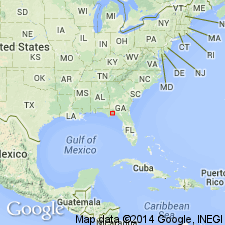
- Usage in publication:
-
- Torreya Formation*
- Modifications:
-
- Named
- Dominant lithology:
-
- Sand
- Marl
- AAPG geologic province:
-
- South Georgia sedimentary province
Summary:
Torreya Formation here named in Liberty Co., north-central FL. Consists 30 m gray to bluish-green sand with lime inclusions, passing gradually into sandy marl. Overlies St. Marks Formation to the east and Chattahoochee Formation to the west. Underlies Chipola Formation to the east and Hawthorn Formation to the west. Age is early Miocene.
Source: GNU records (USGS DDS-6; Reston GNULEX).
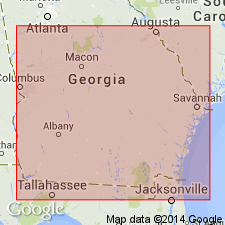
- Usage in publication:
-
- Torreya Formation
- Modifications:
-
- Revised
- Areal extent
- AAPG geologic province:
-
- South GA-North FL sedimentary province
Summary:
The Torreya Formation is here expanded to include all of the Hawthorne Group deposits of the eastern part of the FL panhandle and of southwesternmost GA, up to and including the fuller's earth beds at or near the top of the formation. Unit includes the lower Sopchoppy Member and the upper Dogtown Clay Member (new name). Torreya disconformably or paraconformably overlies the Chattahoochee Formation in FL, but contact relationship in GA is not clear; paraconformably underlies the Chipola Formation at Alum Bluff, FL; upper contact relationship with the Coosawhatchie in the Gulf Trough is not clear; disconformably underlies Miccosukee Formation elsewhere in GA. Age is middle early Miocene (early to middle Burdigalian) based on land mammal faunas believed to be between 17 and 19 Ma.
Source: GNU records (USGS DDS-6; Reston GNULEX).
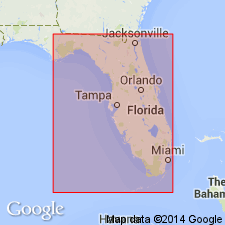
- Usage in publication:
-
- Torreya Formation
- Modifications:
-
- Areal extent
- AAPG geologic province:
-
- South GA-North FL sedimentary province
Summary:
Torreya Formation is the only currently recognized formation of the Hawthorn Group in the eastern panhandle of FL. It includes two named members: the Dogtown and the Sopchoppy. Reference sections are designated in cores in Liberty, Gadsden, and Leon Cos. Unit also occurs in parts of Madison, Jefferson, and Wakulla Cos. Torreya in this area is typically siliciclastic with increasing amounts of carbonate in the lower portion of the section. It disconformably overlies the Chattahoochee and/or St. Marks Formation and disconformably underlies the Citronelle and Miccosukee Formations throughout most of its extent. Unit correlates with Marks Head Formation of northeast FL and southeast GA. Also correlates with upper part of the Arcadia Formation (redefined in this paper) of southern FL. Age is middle early Miocene (early to middle Burdigalian) based on molluskan and vertebrate faunas (Huddlestun, in press).
Source: GNU records (USGS DDS-6; Reston GNULEX).
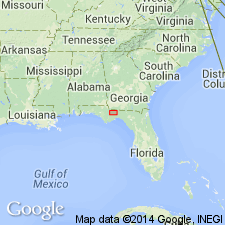
- Usage in publication:
-
- Torreya Formation
- Modifications:
-
- Overview
- AAPG geologic province:
-
- South Georgia sedimentary province
Summary:
Torreya Formation of Hawthorn Group is typically a siliciclastic unit, consisting of a white to light olive-gray, very fine- to medium-grained clayey sand to sandy, silty clay. It frequently contains variable amounts of limestone, dolomite, and phosphate. Carbonate content generally increases in the basal portion of the section. The carbonate portions usually consist of quartz-sandy, clayey limestone or dolomitic limestone. Clays are frequently an abundant in the upper Torreya Formation. The dominant clay minerals are palygorskite and smectite. Fuller's earth is mined form the Torreya near Quincy and Midway and northward into GA. Torreya underlies all of Gadsden Co. Oyster reefs composed of OSTREA NORMALIS and gastropod molds are often associated with the carbonate units, and marine diatoms have been noted in some of the clay. Foraminifera are rare. Unit crops out in bluffs along the east bank of the Apalachicola River. West of the river it is absent. Some exposures occur along the Ochlockonee River in eastern Gadsen Co. Thickness ranges from approximately 100 ft in the western portion of the county to about 230 ft near Quincy. Unit unconformably underlies the Citronelle and Miccosukee Formations and in some areas the Jackson Bluff Formation. Age is early Miocene according to Fig. 6.
Source: GNU records (USGS DDS-6; Reston GNULEX).
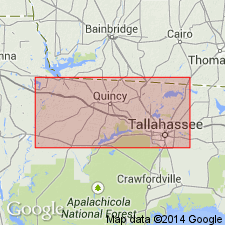
- Usage in publication:
-
- Torreya Formation
- Modifications:
-
- Biostratigraphic dating
- Geochronologic dating
- Age modified
- AAPG geologic province:
-
- Florida platform
Summary:
Dogtown Member of the upper Torreya Formation of Hawthorn Group in northern Gadsden Co., FL, contains an early Barstovian land mammal fauna and has 87Sr/86Sr age estimates between 16.6+/-1.0 and 14.7+/-1.5 Ma. These, together with reversed magnetic polarity constrain the age of the Dogtown in the study area to between 15.9 and 15.3 Ma. Evidence from a second fossil locality indicates that the Dogtown is time transgressive--younger to the north. Age of the Torreya is constrained to late early to early middle Miocene (19 to 15.3 Ma).
Source: GNU records (USGS DDS-6; Reston GNULEX).
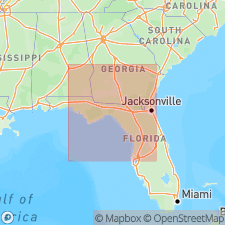
- Usage in publication:
-
- Torreya Formation
- Modifications:
-
- Geochronologic dating
- AAPG geologic province:
-
- Florida platform
Summary:
Authors use 87Sr/86Sr isotopic analyses in an attempt to resolve age relations of fossiliferous marine units that contain the remains of terrestrial vertebrates. An early Miocene mean age of 19.6 Ma was calculated from six samples from the lowermost beds of the Torreya Formation at the Taff Pit in Wakulla Co. One sample from the younger Sopchoppy Limestone Member gave an age of 17.4 Ma.
Source: GNU records (USGS DDS-6; Reston GNULEX).
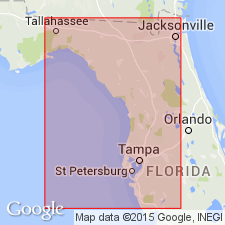
- Usage in publication:
-
- Torreya Formation
- Modifications:
-
- Biostratigraphic dating
- AAPG geologic province:
-
- Florida platform
Summary:
Three of the five early Miocene (Hemingfordian) land mammal sites in FL occur in the Torreya Formation in the eastern panhandle. The Seaboard Local Fauna collected from the lower Torreya in Tallahassee compares closely in age with the late early Hemingfordian (19-18 Ma) Thomas Farm Local Fauna derived from a sinkhole deposit in Gilchrist Co. (The Thomas Farm is one of the best known Miocene vertebrate faunas in eastern North America.) The Griscom Plantation Local Fauna in Leon Co., found in the Torreya, is also early Hemingfordian. The late Hemingfordian Midway Local Fauna was collected from the Dogtown Member in the upper Torreya and indicates a late early Miocene (18-16.5 Ma) age. The Brooks Sink Local Fauna collected from the Marks Head Formation in Bradford Co. is very close in age to the Midway and therefore supports the correlation of the Marks Head with the Torreya suggested by Huddlestun (1988). The Willacoochee Creek Fauna, collected from the top of the Dogtown Member, is early Barstovian in age (early middle Miocene, Langhian, 16-15 Ma. This correlates with the upper part of the Arcadia Formation in the southern peninsula.
Source: GNU records (USGS DDS-6; Reston GNULEX).
For more information, please contact Nancy Stamm, Geologic Names Committee Secretary.
Asterisk (*) indicates published by U.S. Geological Survey authors.
"No current usage" (†) implies that a name has been abandoned or has fallen into disuse. Former usage and, if known, replacement name given in parentheses ( ).
Slash (/) indicates name conflicts with nomenclatural guidelines (CSN, 1933; ACSN, 1961, 1970; NACSN, 1983, 2005, 2021). May be explained within brackets ([ ]).

